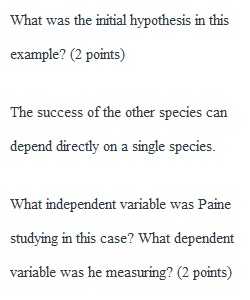


Q The Scientific Method in Ecology The scientific method is not a new idea; it has been utilized by generations of scientists. This activity will introduce you to some of the most famous scientific experiments and discoveries – ones that continue to influence our lives even today! See if you can identify the different parts of the scientific method and experimental design in each. *please make sure to scroll to the end to view the full assignment and the rubric for this assignment. Objectives: • Demonstrate and understanding of the process of scientific inquiry Part A: The Star Hurler An ecologist named Robert Paine believed that, in some ecosystems, the presence or absence of a single species could directly impact the success of many other species. He decided to do an experiment in the cove of a small bay in the northwestern tip of Washington State. He used a crowbar to remove all of the starfish that he found, then threw them as far into the bay as he could, away from the tidepools. He then tracked the diversity of the ecosystem over the next several months. Initially, the population of barnacles and mussels increased rapidly. However, these species overgrazed on the algae that lived along the shore, wiping out a major food source. Within a year of the removal of the starfish, species diversity decreased from 15 to 8 species. He compared his result to a nearby shoreline with an identical community where he had not removed the starfish. This community still had a species diversity of 15 species. https://www.youtube.com/watch?time_continue=3&v=hRGg5it5FMI&feature=emb_logo (Links to an external site.) Based on the lecture notes and the above video answer the following questions: A- 1 What was the initial hypothesis in this example? (2 points) A- 2 What independent variable was Paine studying in this case? What dependent variable was he measuring? (2 points) A-3 What was the experimental group in this study? What was the control group? (2 points) A-4 Why is a control group necessarily in experiments like this, even if they aren’t altered in any way? (2 points) A-5 What conclusion should Dr. Paine draw from his experiment? (2 points) Part B: Peppered Moths Prior to the industrial revolution of the 1800s, the only variety of the peppered moth was white-bodied, as shown to the left. Field collection experiments revealed, however, that as the amount of soot in the area increased around large industrial cities, higher numbers of the black-bodied form of the peppered moth were found. By the end of the 19thcentury, nearly 98% of moths collected were the black-bodied form. . Scientists disagreed about the cause – some believed that the pollution was causing a mutation of the moths, while others felt that the moths were eating bits of the pollution, making their color change. Still others believed that a mechanism of evolution was favoring the dark-bodied moths. Later on, in the 20th century, a scientist named Bernard Kettlewell released both types of moths into a polluted and an unpolluted forest. He found 75% of the moths preyed on by birds in the polluted forest were the white-bodied type, while only 25% were the black-bodied type. In the unpolluted forest, 86% of the moths preyed on were black-bodied ones. B-1 State the three competing hypotheses in this example. (Hint: think about the research question and the different hypotheses mentioned above) (3 points) B-2 What was the independent and dependent variable of Kettlewell’s experiment? (2 points) B-3 Which forest served as the experimental group, and which was the control group of Kettlewell’s experiment? (2 points) B-4 Kettlewell’s experiment supported the evolutionary hypothesis (Kettlewell did not study analyze the DNA mutation or the dietary hypothesis). Design an experiment that could test one of the other two competing hypotheses (DNA mutation or dietary hypotheses). Define the independent and dependent variables, as well as the control and experimental groups. What result would support the hypothesis? What result would cause the hypothesis to be rejected? (3 points) Rubric for Writing Assignment Rubric for Assignments.pdf Download Rubric for Assignments.pdf ________________________________________ How to Complete Your Assignment [File Upload Example] You can submit your work here in the CANVAS system as a 1) .docx (Word document) or 2)other word processing file, 3)(Google Docs (Links to an external site.) is also acceptable. If you are using Google Doc. make sure to give me access at m.danfoura@gmail.com Directions to Submit 1. On the right hand Menu, you will see a SUBMIT ASSIGNMENT button with a white plus sign. 2. Click on the SUBMIT ASSIGNMENT Then click BROWSE to look for your file on your computer. 3. When done, click the SUBMIT ASSIGNMENT button. How to Complete Your Assignment if using Google Docs [URL Example] Submit your work here in the CANVAS system as a URL (Web Link). Directions to Submit 1. On the right hand Menu, you will see a SUBMIT ASSIGNMENT button with a white plus sign. 2. Click on the SUBMIT ASSIGNMENT Then enter in your URL. 3. When done, click the SUBMIT ASSIGNMENT button. PreviousNext
View Related Questions